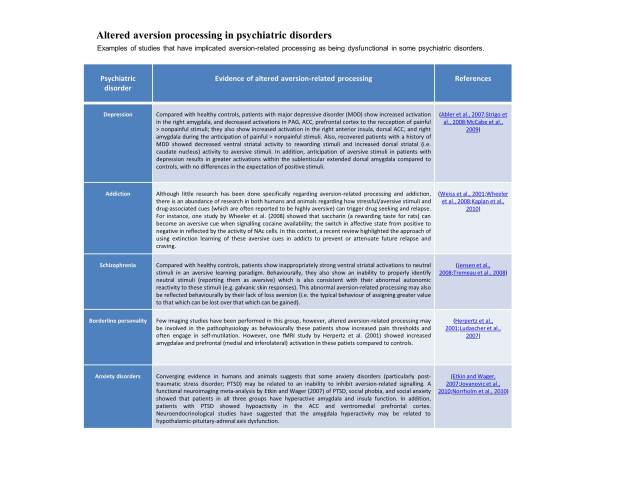 The ability to detect and respond appropriately to aversive things or events in our environment is essential for all organisms, from fruit flies to humans. Although much is known about aversive responding at the psychological level (e.g. displays of fear, disgust) and at the physiological level (e.g. increased heart rate, changes in electrical skin conductance), much less is known at the neuroscientific level.
The ability to detect and respond appropriately to aversive things or events in our environment is essential for all organisms, from fruit flies to humans. Although much is known about aversive responding at the psychological level (e.g. displays of fear, disgust) and at the physiological level (e.g. increased heart rate, changes in electrical skin conductance), much less is known at the neuroscientific level.
.
The amygdala: an archetype
Some of the best work in this regard has come from Joseph LeDoux’s group regarding the complex anatomical and functional mapping of the amygdala. In his own words:
“Not so long ago it was an obscure region of the brain that attracted relatively little scientific interest. Today it is one of the most heavily studied brain areas, and practically a household word.”
His group’s work was not only largely responsible for putting the amygdala on the popular map, it was pioneering in connecting the dots concerning the amygdala’s role as a psychological-physiological-cognitive integrator of emotional information. It’s role in fear processing, for example, is comparatively well understood, as animals without amygdalae, or altered functioning, show robust changes in fear learning.
But the amygdala is not a single structure. While its subregions are interconnected (directly or via a few synapses), they are each connected with many different regions and networks of the brain – leading some to suggest that the amygdala should not be considered a single anatomical or functional unit at all. For instance, while the central nuclei are well connected to autonomic control regions (e.g. PAG, hypothalamus), and thus help control fearful responses like heart rate or freezing, the basal nuclei are more connected to striatal regions associated with controlling motor responses (like running away), and the lateral nuclei are, for instance, more highly connected to sensory cortices.
Basic emotional/affective processing
While there has been quite a lot of emotion-related research on specific areas such as the amygdala, there is much less known of how regions work together as functional networks. Moreover, many of the studies looking at emotional processing from a network perspective (e.g. typically human neuroimaging) often use complex designs which include highly cognitive tasks.
However, there is good reason to believe in the existence of basic emotional (or ‘affective’, to separate them from higher-level concepts) brain circuits. On this front, Jaak Panksepp was one of the first neuroscientists to suggest that all mammals have basic affective processing and, because of this, the affective lives of non-human mammals should be able to provide us with insight into our own primal affective processing.
For a rough psychological example, one can imagine waking up in an (unknowingly) unpleasant mood, until one’s wife or roommate politely suggests they consider going back to bed. Interestingly, when our sour mood is pointed out (or we’re pointedly asked about it), we do realize we’re unhappy (though it still might not be clear why). Nonetheless, the mood preceded explicit awareness (though not phenomenological awareness).
A cross species network approach
All this suggests the existence of a neural network which regulates the most basic aversive processing. Though many studies have looked at the brain’s responses to passive aversive stimuli (i.e. the subject in the experiment experiences an unpleasant event without having any task to do; for example, getting a shock or hearing an annoying sound), few have tried to put all the pieces together to look at which brain areas are commonly activated for any type of aversive stimulus. In general, human imaging studies have highlighted the involvement of various cortical regions, such as the prefrontal cortex, while animal studies have focused largely on subcortical regions like the periaqueductal gray (PAG) and hypothalamus. However, whether and how these regions form a core neural network of aversion-related processing was unclear.
To help clarify this issue, my colleague and I conducted a translational cross-species investigation on aversion in humans (by performing a meta-analysis of all neuroimaging studies where strictly passively experienced aversive stimuli were used) and other animals (mainly rodents). Our results indicated that many similar brain regions in both animals and humans were recruited during passive aversive processing, such as the anterior cingulate cortex, the anterior insula, and the amygdala as well as other subcortical (e.g. thalamus, midbrain) and cortical (e.g. orbitofrontal) areas. Importantly, involvement of these regions remained independent of sensory modality. Our study provided evidence for a network involved in aversion in both humans and other animals.
What’s the point? Potential for the everyday
Many studies have revealed altered reward-related processing in many psychiatric disorders (e.g. major depressive disorder, schizophrenia), but a few relatively recent studies have also implicated dysfunctional aversive processing (see table below from Hayes & Northoff, 2011, for some examples). Understanding the balance between aversion and reward processing in healthy individuals and those with, for instance, major depressive disorder, may tell us something about why, at the biological level, some stimuli result in unexpected emotional processing for those who are depressed (e.g. rating neutral items as being highly negative).
Looking beyond pathology, a better understanding of aversion from the psychological level down to the complex biology will ultimately translate to improvements on the quality of our lives. Knowing, for instance, precisely how our external and internal environments (e.g. the amount of natural light or what we had for breakfast, respectively) impact our affective states, as well as how our brains process the world in a highly context-dependent manner (and often in counterintuitive ways; beyond the oft touted cognitive-emotional divide), is essential to maximizing our happiness and overall well-being.
Selected references
Hayes, D., & Northoff, G. (2011). Identifying a Network of Brain Regions Involved in Aversion-Related Processing: A Cross-Species Translational Investigation Frontiers in Integrative Neuroscience, 5 DOI: 10.3389/fnint.2011.00049
LeDoux, J. (2007). The amygdala Current Biology, 17 (20) DOI: 10.1016/j.cub.2007.08.005
Panksepp J (2011). The basic emotional circuits of mammalian brains: Do animals have affective lives? Neuroscience and biobehavioral reviews, 35 (9), 1791-804 PMID: 21872619
Pessoa, L. (2008). On the relationship between emotion and cognition Nature Reviews Neuroscience, 9 (2), 148-158 DOI: 10.1038/nrn2317




The brain, and its functioning, is proving to be more mysterious than anyone ever conceived of. I’m glad to see so much research being done on the primitive brain centers and its potential to influence the functioning of the higher centers.
Pingback: The aversive brain | Brain Momentum | Scoop.it
Hi Dave,
Thanks for writing this interesting post. I liked your example of experiencing emotions at an unconscious level (is the term used correctly?). Sometimes I have come home feeling a little down without knowing right away why, but when I focus on that emotion I am sometimes reminded of an earlier situation when I had felt the same discomfort (such as when a TA had shown irritation by my not having read the lab procedure thoroughly), and knowing the source of the feeling then helps me dispel the feeling of discomfort. When this happens I experience a small “aha” moment that I’d been carrying a negative emotion all day without being aware of it… maybe one day neuroscience can help us (or is already doing so) to understand these defense mechanisms?
Thank you also for the video links – they help to explain the concepts that you use.
I hope you are well! : )
Pingback: Brain